Related Research Articles
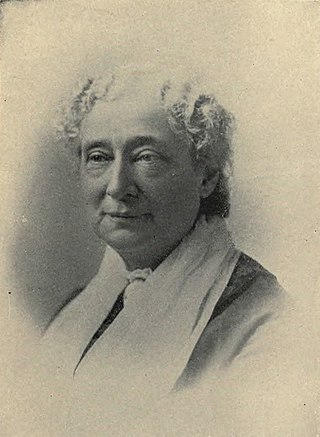
Zerelda Gray Sanders Wallace was the First Lady of Indiana from 1837 to 1840, and a temperance activist, women's suffrage leader, and inspirational speaker in the 1870s and 1880s. She was a charter member of Central Christian Church, the first Christian Church in Indianapolis, Indiana. Her husband was David Wallace, the sixth governor of Indiana; Lew Wallace, one of her stepsons, became an American Civil War general and author.
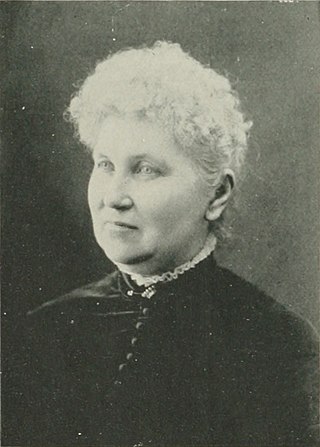
Mary Lydia Doe was a 19th-century American suffragist, temperance reformer, teacher, and author from the U.S. state of Ohio. She served as the first president of the Michigan State Equal Suffrage Association, as well as parliamentarian of the International Label League. She was also the author of a book on parliamentary law. While still a child, she signed the temperance movement pledge under one of the original Washingtonians, later joining the Good Templars and the Woman's Christian Temperance Union.

Catherine Amelia Ewing was an American educator, missionary, philanthropist, activist, and social reformer from the U.S. state of Massachusetts. In 1857, she took in children from the Washington County Infirmary, thus organizing the first children's home in the state of Ohio.
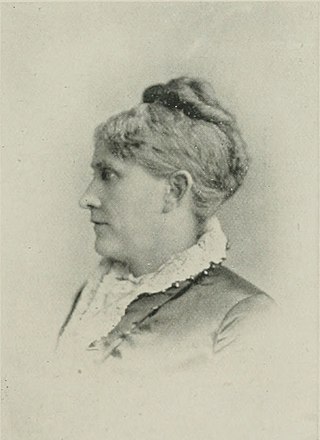
Mary Davy Tenney Gray was a 19th-century American editorial writer, clubwoman, philanthropist, and suffragist from Pennsylvania, who later became a resident of Kansas. She lived in Kansas City, Kansas for more than twenty years and during that time, was identified with almost every woman's movement. She served on the editorial staff of several publications including the New York Teacher, the Leavenworth Home Record, and the Kansas Farmer. Gray's paper on "Women and Kansas City's Development" was awarded the first prize in the competition held by the Women's Auxiliary to the Manufacturers' Association of Kansas City, Missouri.

Elizabeth Morrison Harbert was a 19th-century American author, lecturer, reformer and philanthropist from Indiana. She was the first women to design a woman's plank and secure its adoption by a major political party in a U.S. state.
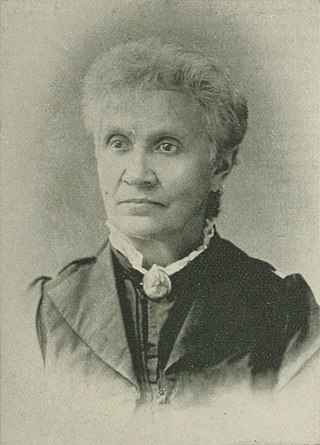
Lucinda Chandler was an American social reformer and author of the long nineteenth century. She was a leader in the social purity movement. She was affiliated with Elizabeth Boynton Harbert.

Sarah Burger Stearns was a social reformer and a leader in the woman's suffrage movement in the U.S. state of Minnesota. She co-founded the Minnesota Woman Suffrage Association and served as its first president.

Ada Chastina Burpee Bowles was a Universalist minister.

Mary Lathrap, pen name: Lena; known as "The Daniel Webster of Prohibition", was a 19th-century American author, preacher, suffragist, and temperance reformer. For 20 years, she was identified with the progressive women of Michigan who had temperance, purity, and prohibition as their watchwords, and the white ribbon as their badge. A licensed preacher for the Methodist Episcopal Church (1871), she served as president of Michigan's Woman's Christian Temperance Union (1882), co-founded the state's suffrage organization (1870), and worked on the amendment campaign (1874). She died in 1895, aged 56.

Elnora E. Monroe Babcock was a pioneer leader in the American suffrage movement. She became actively interested in suffrage work in 1889 and for several years had charge of the press work for the National Woman Suffrage Association. She lived in Dunkirk, New York since 1880. Her name was inscribed on a bronze tablet in the New York State Capitol at Albany, with the names of other prominent suffragists. Babcock died in 1934.
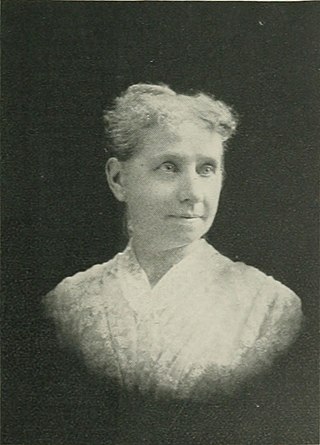
Ellen Sulley Fray was a British-born American social reformer. She formed suffrage clubs in several different states and in Canada, and became one of the district presidents of the Ohio Women's Suffrage Association.

Alice Moore McComas was an American author, editor, lecturer and reformer. She was a pioneer suffragist in California and served as president of the Los Angeles Equal Suffrage Association. During the various suffrage campaigns, McComas contributed articles to over seventy newspapers and magazines, and she was well known throughout the west as an educator and lecturer. She was accredited with being the first woman to conduct a department for women in a daily paper in California, and the first woman to address a state Republican ratification meeting. She was one of the earliest organizers of the Free Kindergarten Association and of clubs for working women, and was prominent in many movements for civic welfare. She was Associate Editor of The Household Journal of California and author of several books, among them The Women of the Canal Zone and Under the Peppers. McComas contributed travel sketches to many magazines. She died in 1919.

Marietta Bones was an American woman suffragist, social reformer, and philanthropist. In 1881 Bones was elected vice-president of the National Woman Suffrage Association (NWSA) and annually re-elected for nine years. In 1890 suffragist Susan B. Anthony and supporters of the movement merged the National Women Suffrage Association into the National American Women Suffrage Association (NAWSA). In 1882, Bones made her first appearance as a public speaker in Webster, soon to be Webster, South Dakota, where she later resided. She was an active temperance worker, and was secretary of the first Non-Partisan National Woman's Christian Temperance Union in 1889. She took great interest in all reform and charitable institutions.

Mary Cole Walling was an American patriot. She was known during the Civil War as "The Banished Heroine of the South." She spoke out for universal suffrage during the war and Reconstruction era. A well-written speech on "Reconstruction and Universal Suffrage", was delivered by Walling in the Senate chamber of the U.S. Capitol at Washington, D.C. May 10, 1866. It was the first time that a woman was ever granted the privilege of speaking there.

Cornelia Collins Hussey was a 19th-century American philanthropist, suffragist, and writer. Her generous financial support had been indispensable to the New Jersey state association. Hussey died in 1902.

Nellie V. Mark was an American physician and suffragist. In addition to looking after her medical practice, she lectured on personal hygiene, literary topics, and on woman suffrage. Mark served as vice-president of the Association for the Advancement of Women. She was a member of Just Government League of Baltimore, the Equal Suffrage League of Baltimore, the National Geographic Society, and the Arundell Club of Baltimore. Mark could not remember a time when she was not a suffragist and a doctor.

Mary Holloway Wilhite was a 19th-century American physician and philanthropist. She was the first female medical graduate from Indiana, as well as the first female practitioner in the state. Wilhite made several important discoveries regarding the effects of medical pharmaceuticals in certain diseases. Her greatest success was in the treatment of women and children. A woman's suffrage and women's rights leader, she was also the founder of the Montgomery County, Indiana Orphans' home. Wilhite contributed regularly to the local newspapers.
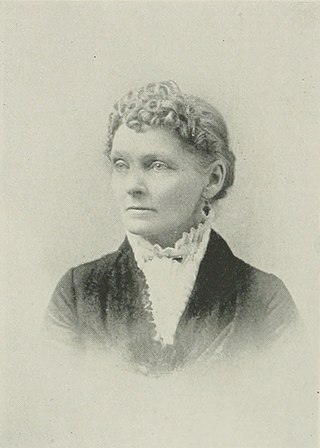
Anna Amelia Churchill Wait (1837–1916) was active in the suffrage movement in Kansas. She is known for establishing an Equal Suffrage Association branch.

Jean Brooks Greenleaf was an American woman suffragist. With her death in 1918, there passed the last of a small group of devoted suffragists who received their first inspiration from Susan B. and Mary Anthony. Greenleaf was the only one of three women who saw their goal come true in New York, the state where they had lived the greater share of their lives.

Sarah Maria Clinton Perkins was an American Universalist minister, social reformer, lecturer, editor, and author of Sunday school books. Early in life, she was engaged in educational work. She was involved in the temperance movement and advocated for women's suffrage. She was an early abolitionist and an early Prohibitionist. Perkins was a highly educated woman, a writer and speaker of rare force. Moving to Cleveland, Ohio, after being widowed in 1880, she was for many years actively connected as National Lecturer with the Woman's Christian Temperance Union (WCTU). She filled various other positions in reform associations including, President of Cleveland's Equal Franchise Club, and president of the Literary Guild of Cleveland.
References
- ↑ Willard & Livermore 1893, p. 307.
- 1 2 3 4 Stanton, Anthony & Gage 1886, p. 971.
- 1 2 3 4 5 6 Willard & Livermore 1893, p. 308.
- ↑ Stanton, Anthony & Gage 1886, p. 972.
Attribution
 This article incorporates text from this source, which is in the public domain :Stanton, Elizabeth Cady; Anthony, Susan B.; Gage, Matilda Joslyn (1886). History of Woman Suffrage: 1876-1885 (Public domain ed.). Fowler & Wells. p. 971.
This article incorporates text from this source, which is in the public domain :Stanton, Elizabeth Cady; Anthony, Susan B.; Gage, Matilda Joslyn (1886). History of Woman Suffrage: 1876-1885 (Public domain ed.). Fowler & Wells. p. 971. This article incorporates text from this source, which is in the public domain :Willard, Frances Elizabeth; Livermore, Mary Ashton Rice (1893). A Woman of the Century: Fourteen Hundred-seventy Biographical Sketches Accompanied by Portraits of Leading American Women in All Walks of Life (Public domain ed.). Moulton. p. 307.
This article incorporates text from this source, which is in the public domain :Willard, Frances Elizabeth; Livermore, Mary Ashton Rice (1893). A Woman of the Century: Fourteen Hundred-seventy Biographical Sketches Accompanied by Portraits of Leading American Women in All Walks of Life (Public domain ed.). Moulton. p. 307.